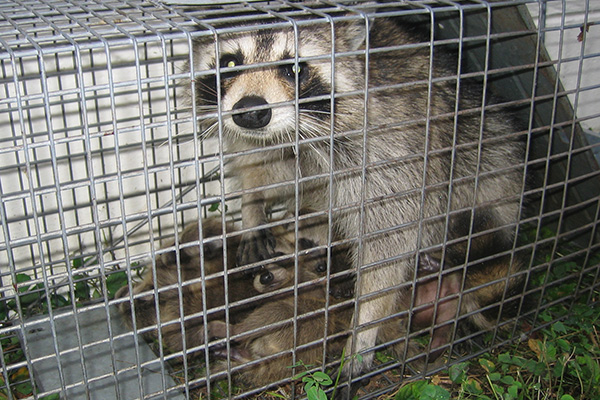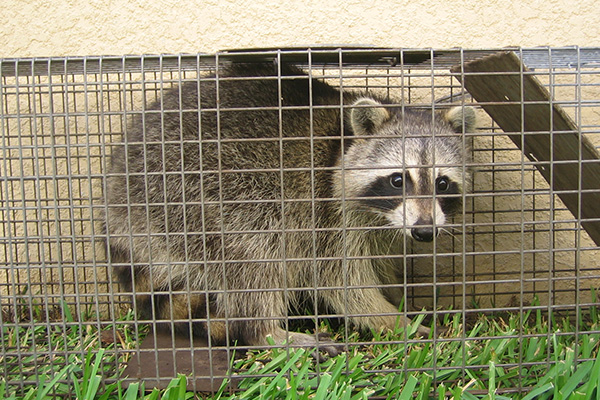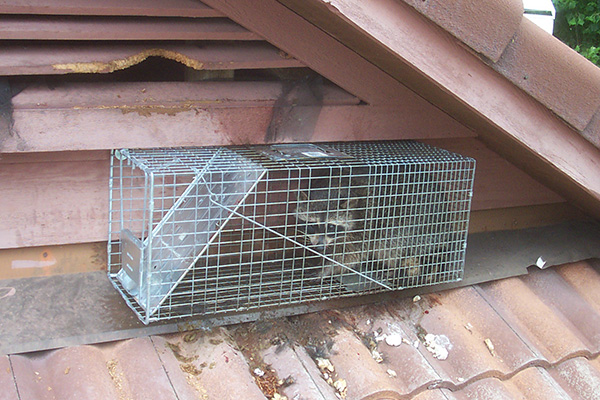- info@animalatticpest.com
- Call - we service 300 locations

How to Trap Raccoons - Raccoon Trapping Tips
While there are some approaches to removing raccoons from the attic without trapping them, in most cases this remains the best option. The best method is actually to use the nest of babies as "live bait" to catch the adult female. After you remove them, place them in the back of a cage trap with a trap divider, and she will go in. (You MUST install barriers on both sides of the trap so that the raccoon can't reach in and trip the trap.) You'll then have the whole family together, and you can relocate them together. That's the best chance of survival for the young. Otherwise, you can bring them to a rehabber. You can also trap raccoons by mounting a trap directly over the entry/exit hole she is using. With heavy steel mesh, she will have no choice but to go in. You could quite possibly trap her with a baited cage trap set outside, either mounted on the roof near the entry hole, or even on the ground near the climing point. But beware, a ground trap can catch any animal in the area. Never place a trap inside an attic - raccoons will NEVER enter there. I don't know why, but it is a guaranteed fact. Never set outside traps if the young are immobile in a nest in the attic. You might not be able to find the young, and then you have a disaster on your hands, in my opinion. Although bait is a secondary factor, if you're not using the babies to lure the female into a cage, read about the best type of raccoon bait to use. Also, you must be very mindful of trap placement. Raccoons reach out of the cage and destroy everything within reach. You must also be careful when transporting a caged raccoon for this reason. In addition, you'll want to relocate them at least 10 miles away from the capture site, because like most animals, they are very good at tracking their way back to their home territory. If you want to hire someone to do this, read more about how much does raccoon removal cost.
Photographs of Various Raccoon Trapping Sets
Use the Pups as Bait
The best way to catch the mothe raccoon, by far, is to use her live pups as bait in the back of a cage trap. You'll catch her usually within under an hour!
Don't Set Bait on the Ground
Only trap on the ground when you have the litter of raccoon pups as bait. If you set a baited cage trap on the ground, you can catch a non-target animal.
Set Near the Entry Hole
If you don't have the pups, set the trap on the roof, next to the entry hole. Be sure to bolt the trap down tight, and make sure the shingles don't get damaged.
Information and Tips About Raccoon Trapping
Raccoon Trapping Tip #1 Never set a trap inside the attic itself. Raccoons simply will not enter a trap inside the attic. I don't know why this is, but it's simply a true part of raccoon behavior.
They will only enter a trap outside.
Raccoon Trapping Tip #2 Be aware that there is almost surely a mother raccoon with babies in the attic. The babies are movile after about 6-8 weeks, but they don't start to leave the attic with the mother
on nightly foraging excursions until they are 12 weeks old. If you catch a single female with swollen nipples (even if you can't see them), the young are trapped inside! In that case, you must either remove the nest of
young by hand, or let the mother go, and wait for the young to grow to 12 weeks old. Don't worry, you can easily catch her again, with the other 4-5 young raccoons.
Raccoon Trapping Tip #3 The best bait is actually the baby raccoons. Remove them from the attic first, (read how on my raccoon nest page) and place them
in the back of a cage trap using a trap divider. This is a difficult set for amatuers. You must make ABSOLUTELY CERTAIN that the raccoon can't trip the trap from the outside, trying to reachin for her pups. If that
happens, you will end up with a desperate female who might severely injure or even kill her young as she tries to get them out. You have to install barriers on both sides of the trap so that the raccoon can't reach in.
Raccoon Trapping Tip #4 If you are unable to trap the adult raccoon with the pups as bait, your next best bet is to set a cage trap mounted on the exit hole. In this type of set, the raccoon has no choice
but to enter the trap as it exits the attic. Use heavy-duty steel screen to force the animal into the trap. No bait is required or even useful in this type of set. Look here for photos of this type of trap Mounted on a Chimney.
Raccoon Trapping Tip #5 If you can't get the young and can't mount a trap on the hole, the next best bet is the mount the trap on the roof. Be sure to put steel screen below the trap with a perimeter of
at least 12 inches on each side, so that the raccoon can't tear up the surrounding shingles. You can also set a trap on the ground if you can identify a place to crawl up. As usual, the normal trapping caveats apply:
use the right type of trap (in this case a large steel raccoon trap at least 30x30x12 inches) and set it correctly, and be sure the set the trap in the shade, be sure to check it very frequently, be sure to treat the
caged animal with caution and care, etc. Read more about raccoon bait here.
Raccoon Trapping Tip #6 Relocate any trapped raccoons as quickly as possible. They almost always injure themselves frantically clawing around for a way out. They can also
succumb to heat stroke or death by exhaustion. And to be sure they don't come back to your house, relocate them at least 10 miles away. That may seem further than necessary, but animals are amazing at tracking
their way home. But most of all, be sure you have the pups, and relocate them all together. It's a terrible thing to trap the mother raccoon and take her away from the cubs while nursing and leave her alone and searching
and the young alone to die.
The Bottom Line
Trapping raccoons in the attic. Remember, do not set cage traps inside the attic. Remember to get the young raccoons, and don't just trap the mother. You can use the young as bait to catch the mom! You can also set a trap at the hole so that she is forced into the trap as she comes out. You can trap raccoons in the attic if you follow the correct approach. Best of luck!




